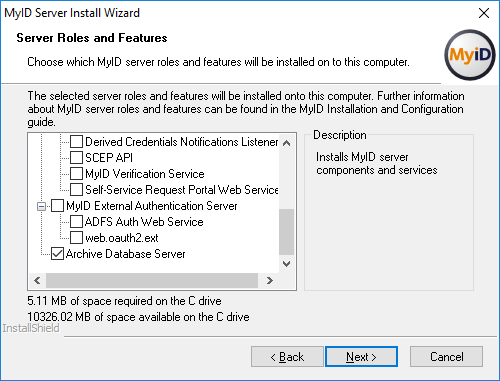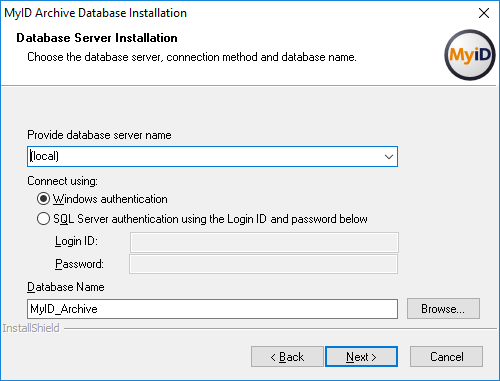4.1 Creating an archive database
You can use the MyID installation program to create an archive database; an archive database is an empty copy of the MyID database that you can use for several purposes, not just as an archive, including:
-
A database for archiving the audit trail, server events, or jobs.
-
A separate audit database.
-
A separate binary objects database.
To create an archive database:
-
Back up the UDL files used for MyID.
These files are stored in the Windows System32 folder. Back up the following files:
-
<databasename>.udl
where <databasename> is the name you provided in the installation for the main MyID database ; for example, MyID.udl.
-
<databasename>archive.udl
For example, MyIDarchive.udl.
-
<databasename>audit.udl
For example, MyIDaudit.udl.
-
<databasename>auth.udl
For example, MyIDauth.udl.
-
<databasename>binary.udl
For example, MyIDbinary.udl.
-
import.udl
-
importarchive.udl
-
importaudit.udl
-
-
Run the MyID installation program.
The MyID installation program is in the Installer folder in the installation media; for example:
Installer\MyIDServer-12.9.0.exe
Note: If you need more than one additional database (for example, an audit database, an archive database, and a binary database) you must run the installer from a PC that does not have MyID installed. You can create only one archive database from each installation.
In this case, you do not want MyID installed on the PC, as you do not want to change any of the installed components – all you want to do is use the Archive Database Server option to create an additional database.
-
At the Server Roles and Features screen, select the Archive Database Server option:
Note: If you are modifying an existing installation, do not change any of the other options. If you are running the installation from a PC that does not have MyID already installed on it, do not select any of the other options.
- Click Next.
-
Type the User Name and Password for the MyID COM user, then click Next.
The MyID Archive Database Installation screen appears:
-
Select the Database Server from the drop-down list.
You may want to store your archive database on a different server from the main MyID database.
- Type the Database Name for the new database.
-
Click Next.
Important: When the installation has completed, if you have any updates installed on your system (that is, patches, hotfixes, and configuration updates), you must apply them to the new database to ensure that the structure and operation data of the additional database matches the main database.
4.1.1 Configuring the data link files
If you run the installation program from the MyID application server, it updates the following Universal Data Link (UDL) files to point to the new database:
-
<databasename>archive.udl
where <databasename> is the name of the main MyID database ; for example, MyIDarchive.udl
-
importarchive.udl
If you are creating the database for an archive database to store your archived audit trail, system events, or jobs, and you run the installation program from the MyID application server, you do not need to carry out any further manual configuration.
If you run the installation program from the MyID application server, and you are creating the database for another purpose (that is, for an audit database, or a binary objects database) you must reset these UDL files to point to the database you previously used; you can restore the files from the backup you took before you ran the installation program to create the archive database.
If you run the installation program from a PC other than the MyID application server, or you are creating the database as an audit or binary objects database, you must update the appropriate UDL files on the application server to point to the new database:
-
Archive database – update the following UDL files:
-
<databasename>archive.udl
where <databasename> is the name of the main MyID database ; for example, MyIDarchive.udl
-
importarchive.udl
-
-
Audit database – update the following UDL files:
-
<databasename>audit.udl
where <databasename> is the name of the main MyID database ; for example, MyIDaudit.udl
-
importaudit.udl
-
-
Binary objects database – update the following UDL file:
-
<databasename>binary.udl
-
To update a UDL file:
- On the MyID application server, open a Windows command prompt as an Administrator.
- Navigate to the Windows System32 folder.
-
Type the name of the appropriate .udl file, then press Enter.
This opens the Data Link Properties dialog, which allows you to change the data link file.
- Set the properties to point to the server and database you created.

